transfer Alfa Romeo Stelvio 2019 Owner's Manual
[x] Cancel search | Manufacturer: ALFA ROMEO, Model Year: 2019, Model line: Stelvio, Model: Alfa Romeo Stelvio 2019Pages: 244, PDF Size: 4.95 MB
Page 75 of 244

turning more than it should according to
the angle of the steering wheel.
Understeer: occurs when the vehicle is
turning less than it should according to
the angle of the steering wheel.
System intervention
The intervention of the system is
indicated by the flashing of the ESC
warning light on the instrument panel, to
inform the driver that the vehicle
stability and grip are critical.
37) 38) 39) 40) 41)
TC (Traction Control)SYSTEM
The system automatically operates in the
event of slipping, loss of grip on wet
roads (aquaplaning) and acceleration on
slippery, snowy or icy roads, etc. on one
or both drive wheels. Depending on the
slipping conditions, two different control
systems are activated:
if the slipping involves both drive
wheels, the system intervenes, reducing
the power transmitted by the engine;
if the slipping only involves one of the
drive wheels, the BLD (Brake Limited
Differential) function is activated,
automatically braking the wheel which is
slipping (the behaviour of a self-locking
differential is simulated). This will
increase the engine torque transferred to
the wheel which isn't slipping.System intervention
The intervention of the system is
indicated by the flashing of the ESC
warning light on the instrument panel, to
inform the driver that the vehicle
stability and grip are critical.
42) 43) 44) 45) 46)
PBA (Panic Brake Assist)SYSTEM
The PBA system is designed to improve
the vehicle’s braking capacity during
emergency braking.
The system detects emergency braking
by monitoring the speed and force with
which the brake pedal is pressed, and
consequently applies the optimal brake
pressure. This can reduce the braking
distance: the PBA system therefore
complements the ABS.
Maximum assistance from the PBA
system is obtained by pressing the brake
pedal very quickly. In addition, the brake
pedal should be pressed continuously
during braking, avoiding intermittent
presses, to get the most out of the
system. Do not reduce pressure on the
brake pedal until braking is no longer
necessary.
The PBA system is deactivated when the
brake pedal is released.
47) 48) 49)
HSA (Hill Start Assist)SYSTEM
This is an integral part of the ESC system
and facilitates starting on slopes,
activating automatically in the following
cases:
uphill: vehicle stationary on a road
with a gradient higher than 5%, engine
running, brake pressed and transmission
in neutral or gear other than reverse
engaged;
downhill: vehicle stationary on a road
with a gradient higher than 5%, engine
running, brake pressed and reverse gear
engaged.
When setting off, the ESC system control
unit maintains the braking pressure on
the wheels until the engine torque
necessary for starting is reached, or in
any case for a maximum of 2 seconds,
allowing your right foot to be moved
easily from the brake pedal to the
accelerator.
When two seconds have elapsed, without
starting, the system is automatically
deactivated, gradually releasing the
braking pressure. During this release
stage it is possible to hear a typical
mechanical brake release noise,
indicating the imminent movement of the
car.
50) 51)
73
Page 168 of 244
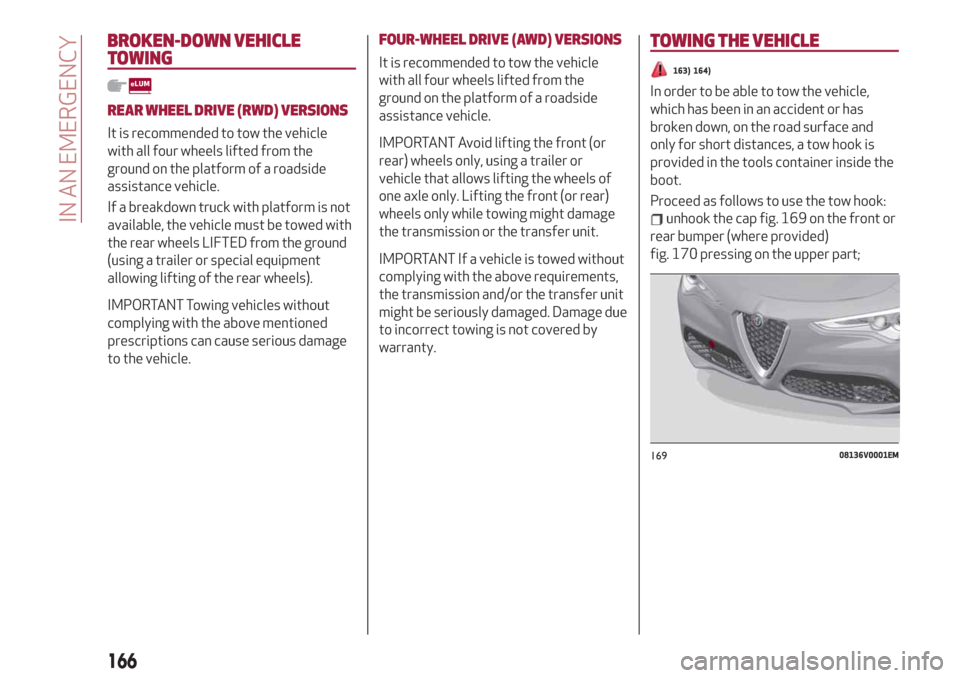
BROKEN-DOWN VEHICLE
TOWING
REAR WHEEL DRIVE (RWD) VERSIONS
It is recommended to tow the vehicle
with all four wheels lifted from the
ground on the platform of a roadside
assistance vehicle.
If a breakdown truck with platform is not
available, the vehicle must be towed with
the rear wheels LIFTED from the ground
(using a trailer or special equipment
allowing lifting of the rear wheels).
IMPORTANT Towing vehicles without
complying with the above mentioned
prescriptions can cause serious damage
to the vehicle.FOUR-WHEEL DRIVE (AWD) VERSIONS
It is recommended to tow the vehicle
with all four wheels lifted from the
ground on the platform of a roadside
assistance vehicle.
IMPORTANT Avoid lifting the front (or
rear) wheels only, using a trailer or
vehicle that allows lifting the wheels of
one axle only. Lifting the front (or rear)
wheels only while towing might damage
the transmission or the transfer unit.
IMPORTANT If a vehicle is towed without
complying with the above requirements,
the transmission and/or the transfer unit
might be seriously damaged. Damage due
to incorrect towing is not covered by
warranty.
TOWING THE VEHICLE
163) 164)
In order to be able to tow the vehicle,
which has been in an accident or has
broken down, on the road surface and
only for short distances, a tow hook is
provided in the tools container inside the
boot.
Proceed as follows to use the tow hook:
unhook the cap fig. 169 on the front or
rear bumper (where provided)
fig. 170 pressing on the upper part;
16908136V0001EM
166
IN AN EMERGENCY
Page 175 of 244
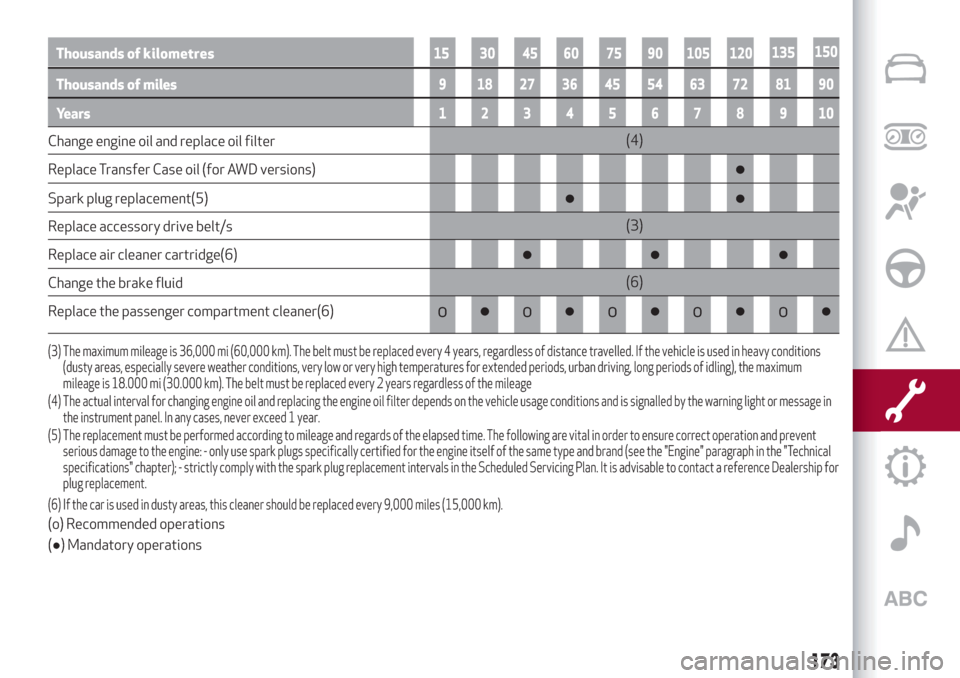
Thousands of miles9 18273645546372 8190
Years12345678 910
Change engine oil and replace oil filter(4)
Replace Transfer Case oil (for AWD versions)
●
Spark plug replacement(5)●●
Replace accessory drive belt/s(3)
Replace air cleaner cartridge(6)
●●●
Change the brake fluid(6)
Replace the passenger compartment cleaner(6)
o●o●o●o●o●
(4) The actual interval for changing engine oil and replacing the engine oil filter depends on the vehicle usage conditions and is signalled by the warning light or message in
the instrument panel. In any cases, never exceed 1 year.
(5) The replacement must be performed according to mileage and regards of the elapsed time. The following are vital in order to ensure correct operation and prevent
serious damage to the engine: - only use spark plugs specifically certified for the engine itself of the same type and brand (see the "Engine" paragraphin the "Technical
specifications" chapter); - strictly comply with the spark plug replacement intervals in the Scheduled Servicing Plan. It is advisable to contact a reference Dealership for
plug replacement. (3) The maximum mileage is 36,000 mi (60,000 km). The belt must be replaced every 4 years, regardless of distance travelled. If the vehicle is used in heavy conditions
(dusty areas, especially severe weather conditions, very low or very high temperatures for extended periods, urban driving, long periods of idling), the maximum
mileage is 18.000 mi (30.000 km). The belt must be replaced every 2 years regardless of the mileage
(6) If the car is used in dusty areas, this cleaner should be replaced every 9,000 miles (15,000 km).
(o) Recommended operations
(●) Mandatory operations
173
Thousands ofkilometres15 30 45 60 75 90 105 120135150
Page 178 of 244

Thousands of miles12 24 36 48 60 72 84 96 108 120
Years12345678910
Replace Transfer Case oil (for AWD versions)●
Replace accessory drive belt/s(4)
Replace the toothed timing drive belt(4)
Replace air cleaner cartridge(6)
●●●
Replace fuel filter cartridge(7)●●●
Change the brake fluid(8)
Replace the passenger compartment cleaner
●●●●●
(4) The maximum mileage is 72,000 mi (120,000 km). The belt must be replaced every 5 years, regardless of distance travelled. If the vehicle is used in heavy conditions
(dusty areas, especially severe weather conditions, very low or very high temperatures for extended periods, urban driving, long periods of idling), the maximum
mileage is 36,000 mi (60,000 km). The belt must be replaced every 4 years regardless of the mileage
(6) If the car is used in dusty areas, this cleaner should be replaced every 12,000 miles (20,000 km).
(7) If the car runs on fuel with quality below the relevant European specification, this filter must be replaced every 12,000 miles (20,000 km).
(8) The brake fluid replacement has to be done every two years, irrespective of the mileage.
(o) Recommended operations
(●) Mandatory operations
176
SERVICING AND CARE
Thousands ofkilometres20 40 60 80 100 120 140 160 180200
Page 206 of 244
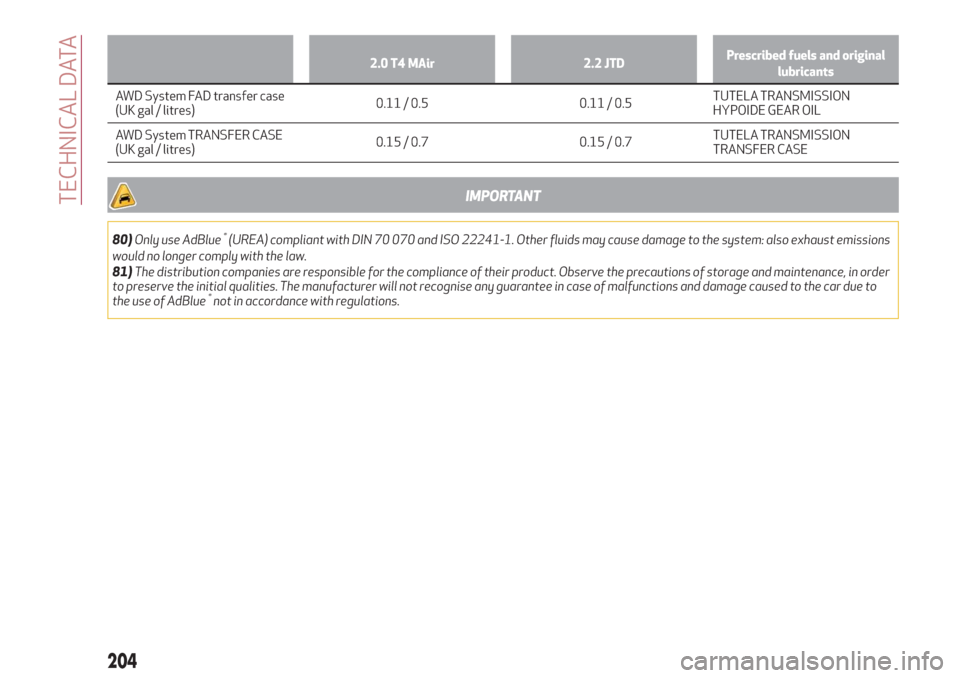
2.0 T4 MAir 2.2 JTDPrescribed fuels and original
lubricants
AWD System FAD transfer case
(UK gal / litres)0.11 / 0.5 0.11 / 0.5TUTELA TRANSMISSION
HYPOIDE GEAR OIL
AWD System TRANSFER CASE
(UK gal / litres)0.15 / 0.7 0.15 / 0.7TUTELA TRANSMISSION
TRANSFER CASE
IMPORTANT
80)Only use AdBlue®(UREA) compliant with DIN 70 070 and ISO 22241-1. Other fluids may cause damage to the system: also exhaust emissions
would no longer comply with the law.
81)The distribution companies are responsible for the compliance of their product. Observe the precautions of storage and maintenance, in order
to preserve the initial qualities. The manufacturer will not recognise any guarantee in case of malfunctions and damage caused to the car due to
the use of AdBlue
®not in accordance with regulations.
204
TECHNICAL DATA
Page 208 of 244
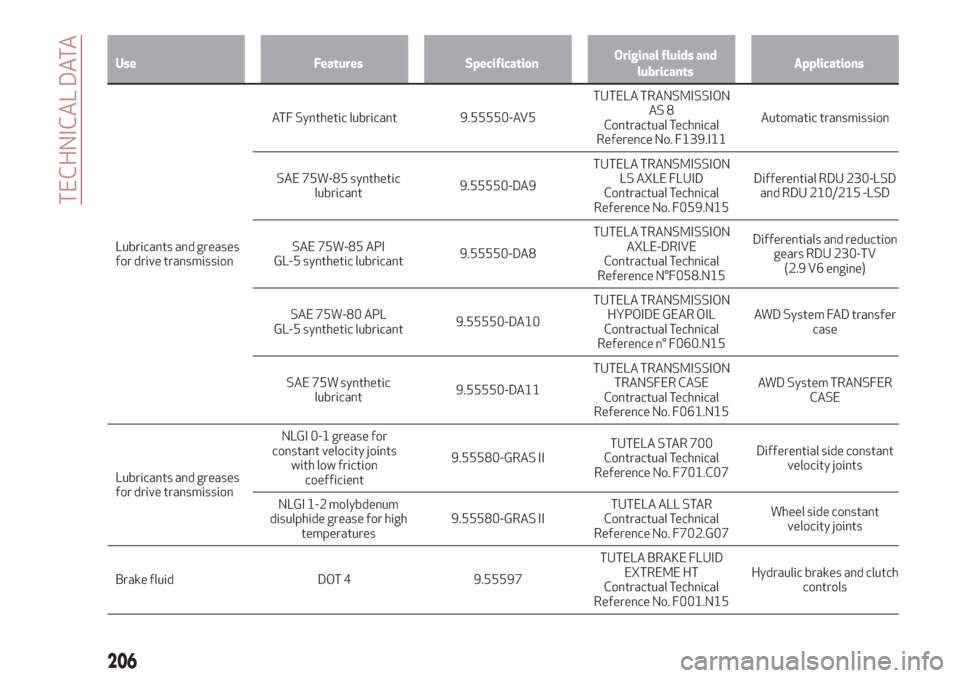
Use Features SpecificationOriginal fluids and
lubricantsApplications
Lubricants and greases
fordrive transmissionATF Synthetic lubricant 9.55550-AV5TUTELA TRANSMISSION
AS 8
Contractual Technical
Reference No. F139.I11Automatic transmission
SAE 75W-85 synthetic
lubricant9.55550-DA9TUTELA TRANSMISSION
LS AXLE FLUID
Contractual Technical
Reference No. F059.N15Differential RDU 230-LSD
and RDU 210/215 -LSD
SAE 75W-85 API
GL-5 synthetic lubricant9.55550-DA8TUTELA TRANSMISSION
AXLE-DRIVE
Contractual Technical
Reference N°F058.N15Differentials and reduction
gears RDU 230-TV
(2.9 V6 engine)
SAE 75W-80 APL
GL-5 synthetic lubricant9.55550-DA10TUTELA TRANSMISSION
HYPOIDE GEAR OIL
Contractual Technical
Reference n° F060.N15AWD System FAD transfer
case
SAE 75W synthetic
lubricant9.55550-DA11TUTELA TRANSMISSION
TRANSFER CASE
Contractual Technical
Reference No. F061.N15AWD System TRANSFER
CASE
Lubricants and greases
for drive transmissionNLGI 0-1 grease for
constant velocity joints
with low friction
coefficient9.55580-GRAS IITUTELA STAR 700
Contractual Technical
Reference No. F701.C07Differential side constant
velocity joints
NLGI 1-2 molybdenum
disulphide grease for high
temperatures9.55580-GRAS IITUTELA ALL STAR
Contractual Technical
Reference No. F702.G07Wheel side constant
velocity joints
Brake fluid DOT 4 9.55597TUTELA BRAKE FLUID
EXTREME HT
Contractual Technical
Reference No. F001.N15Hydraulic brakes and clutch
controls
206
TECHNICAL DATA
Page 223 of 244
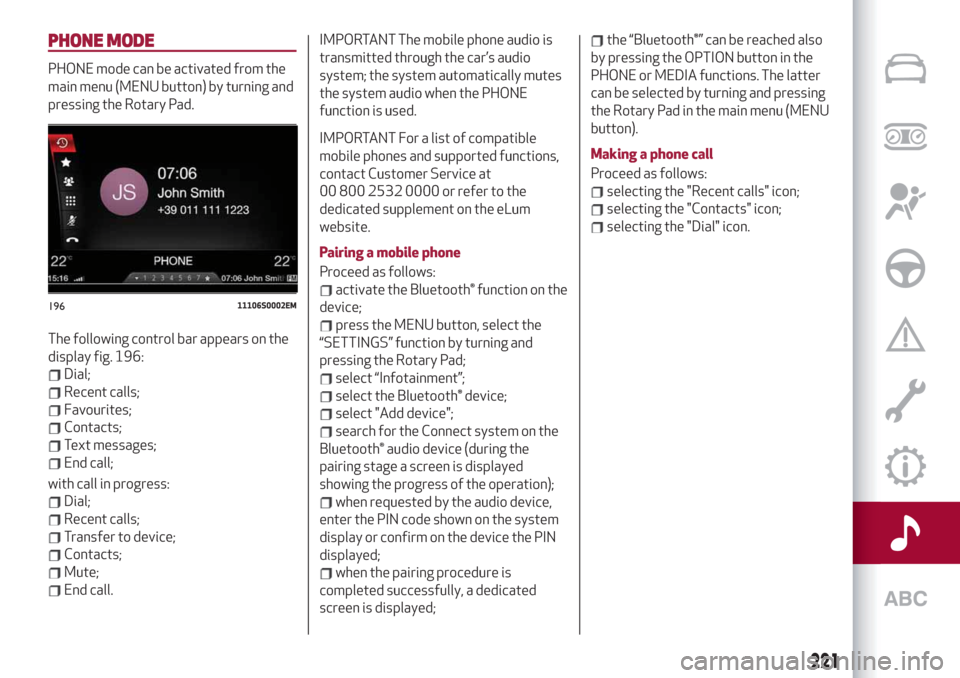
PHONE MODE
PHONE mode can be activated from the
main menu (MENU button) by turning and
pressing the Rotary Pad.
The following control bar appears on the
display fig. 196:
Dial;
Recent calls;
Favourites;
Contacts;
Text messages;
End call;
with call in progress:
Dial;
Recent calls;
Transfer to device;
Contacts;
Mute;
End call.
IMPORTANT The mobile phone audio is
transmitted through the car’s audio
system; the system automatically mutes
the system audio when the PHONE
function is used.
IMPORTANT For a list of compatible
mobile phones and supported functions,
contact Customer Service at
00 800 2532 0000 or refer to the
dedicated supplement on the eLum
website.
Pairing a mobile phone
Proceed as follows:
activate the Bluetooth® function on the
device;
press the MENU button, select the
“SETTINGS” function by turning and
pressing the Rotary Pad;
select “Infotainment”;
select the Bluetooth® device;
select "Add device";
search for the Connect system on the
Bluetooth® audio device (during the
pairing stage a screen is displayed
showing the progress of the operation);
when requested by the audio device,
enter the PIN code shown on the system
display or confirm on the device the PIN
displayed;
when the pairing procedure is
completed successfully, a dedicated
screen is displayed;
the “Bluetooth®” can be reached also
by pressing the OPTION button in the
PHONE or MEDIA functions. The latter
can be selected by turning and pressing
the Rotary Pad in the main menu (MENU
button).
Making a phone call
Proceed as follows:
selecting the "Recent calls" icon;
selecting the "Contacts" icon;
selecting the "Dial" icon.
19611106S0002EM
221